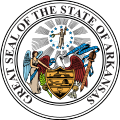| The Great Seal of Arkansas | |
|---|---|
 | |
| Versions | |
 | |
| Armiger | State of Arkansas |
| Adopted | May 3, 1864 (modifications made in 1907) |
| Motto | Latin: Regnat populus, lit. 'The people rule' |
| Earlier version(s) | 1820–1836, the Arkansas Territory; 1836–1864, the State of Arkansas; 1864–1865, Arkansas government in exile at Washington, Arkansas |
The Great Seal of Arkansas is used to authenticate certain documents issued by the Government of Arkansas. The phrase is used both for the physical seal itself, which is kept by the governor, and more generally for the design impressed upon it. The seal was modified to its present form on May 23, 1907.




